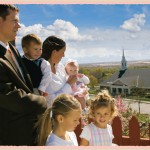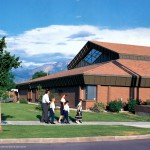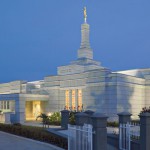Non-Mormons often wonder about the difference between Mormon chapels (or “churches”) and temples.

Chapels
Mormon chapels are the workhorses of Mormon worship. They are used for Sunday meetings of adults, youth, and children. Visitors are welcome and encouraged to attend.
Most Mormon chapels include:
- the chapel itself, where members worship on Sunday and take the sacrament (analogous to “communion” or “Eucharist” in other Christian faiths)
- multiple classrooms for instruction
- a kitchen for food preparation
- a gymnasium or other recreational area that may also serve as classroom space on Sundays
- offices for church leaders of local congregations
- a library of books, videos, pictures, and other equipment for teaching

Many meetinghouses also include a baptismal font for the baptism of converts and children of members. In some areas, computers and other equipment for family history research are also located here.
For Sunday services, men typically wear a suit coat and tie, while women generally wear dresses. During week-day activities, clothing varies from jeans to Sunday wear depending on the nature of the activity. (Dress will also vary depending on world-wide location–the description offered here applies to the United States, Canada, and western Europe).
Chapels are used on Sunday for worship service, and during the week for Church activities and youth groups. Chapels are also sometimes used for community events, as polling stations, or as shelters during natural disasters.
Temples

Temples serve solely as locations for the performance of religious ceremonies, such as vicarious baptism and marriage. They are not used for Sunday worship, and are closed on the Sabbath.
They include multiple small rooms for the performance of religious ceremonies. They also include a few administrative offices and changing rooms which allow patrons to don the white clothing they wear in the temple. Larger temples may include a cafeteria and laundry, but smaller temples with lower patron volumes usually forgo these amenities.
Prior to dedication, visitors and neighbors are invited to tour Mormon temples. Following their dedication, only Mormons in good standing may enter temples.
Because of their sacred nature, temples are constructed to much higher standards of workmanship and materials than chapels.
